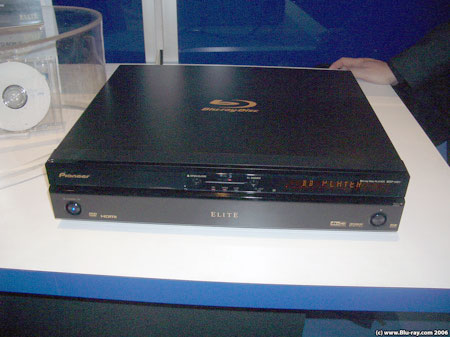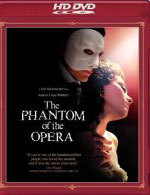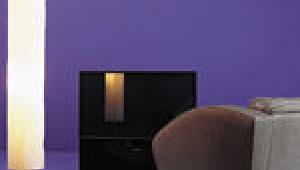HD DVD and Blu-ray Disc 2006: An In-Depth Report Page 2
Indeed, at industry trade shows video expert Joe Kane has shown knockout quality 720p HD video encoded with VC-1 running at data rates equivalent to high bitrate standard DVDs. According to Toshiba's representatives, the HD DVD demonstrations at CES showed a variety of material encoded with AVC or VC-1, not MPEG-2. At other industry demonstrations 1080p video crunched with the new codecs running at just 12-14Mbps also looked promising. But our exposure so far is too limited to make any serious judgments.

In announcing the first Blu-ray titles Sony specified that at least BD's initial offerings will use the tried and true MPEG-2 compression. BD, due to its larger capacity will be running MPEG-2 at video bitrates over 20 Mbps, and at those rates Sony claims the performance advantages of the new compression schemes are nullified or even surpassed. While the performance of the newer codecs at lower rates is something we can only comment on after we see it, we can say unequivocally that the MPEG-2-encoded HD we've been watching for the last several years on broadcast and satellite, which is often encoded around 20 Mbps, is nothing short of spectacular in image quality. And we haven't even seen 1080p yet!
Both HD DVD and Blu-ray are capable of data transfer rates far in excess of the current DVD format. HD DVD maxes out at 36Mbps, and Blu-ray at 54Mbps (in the latter case it's not 100% clear that first-gen BD players will support this "1.5x throughput, but it is known that BD players will support at least 36Mbps from the get-go.)
Both formats are capable of carrying video resolution of 1920x1080, progressive, and both have currently specified that even their initial releases will in fact carry 1080p/24 fps (frames per second) for film-based material. This is the top of the food chain not only in terms of pure resolution, but also has the potential of eliminating motion artifacts for the few and proud displays out there that can display 1080p/24 native by virtue of taking 3/2 pulldown out of the equation entirely. A frame rate of 24fps must be doubled to 48fps by the display—or even better tripled to 72fps—to minimize or eliminate flicker.
While 1080p offers the potential of the best video quality we've yet seen outside of the best movie theaters showing the very best prints, its presence on these discs brings a lot of "buts"to the table with it. First, most current displays, even many of those with 1920x1080 resolution, cannot accept a 1080p/24 signal directly. HD DVD and BD players will reportedly perform 3/2 pulldown on the fly and output 1080i/60 for film-based sources to get around this, but whether this additional processing will have a deleterious effect on the image quality is unknown. Certainly, the deinterlacing quality of the display will play a role as well.
Also, according to recent correspondences with Toshiba representatives, the first generation of HD DVD players will not pass 1080p video at all, even though that is to be the native rate of the video that's encoded on the HD DVD discs. These players will convert the image from the discs to 1080i/60. It is not known at this time if a firmware upgrade can remedy this, or if it will only be solved by upgrading to a second generation player (or simply waiting for the second gen players, as if people need yet anther reason to wait out the format launches a bit.) Toshiba believes this is a non-issue due to the paucity of displays that can accept a native 1080p signal, and certainly there's no denying that 1080i HD is nothing short of spectacular.

Pioneer Elite BDP-HD1 Blu-ray Disc Player
In light of this news, manufacturers in the Blu-ray camp are quite happy to report that the first-gen players from Sony, Samsung, Pioneer, and Panasonic will all output full 1080p to displays that are compatible, in addition to offering conversion to 1080i for displays that are not.
What We'll Hear
For obvious reasons, picture quality gets a lot of run when the new formats are discussed. But with the next-gen formats we are finally starting to leave lossy audio compression behind. Both formats are spec'd for compatibility with uncompressed, high resolution PCM at up to eight channels. BD can handle eight channels of 24-bit/192kHz, while HD DVD maxes out at eight channels of uncompressed 24/96 (keep in mind that movie soundtrack digital masters are typically as low as 16-bits at 44 or 48kHz; some newer releases may offer 24/48kHz).
In another move made possible by BD's storage capacity, Sony has already specified that all Sony/MGM BD releases will in fact contain multichannel uncompressed linear PCM soundtracks. The best digital sound I have ever heard in a movie theater, by several orders of magnitude, is discrete multichannel uncompressed linear PCM (I heard this in an early digital projection presentation, played back from hard drive.) The sound had seemingly limitless dynamics, and yet was full-bodied and entirely effortless. There was striking clarity, and yet no hint of glare or brightness. Having this kind of sound at home will undoubtedly improve the sound of both movie soundtracks and music videos/concerts dramatically.
 In addition to uncompressed PCM, Dolby and DTS will be doing what they best, licensing a variety of new surround sound flavors to take advantage of the bigger bit buckets of the new formats. These will begin with lossy formats that aren't as highly compressed as current DTS and Dolby Digital, and both companies will offer "lossless"codecs with bit for bit reconstruction of the original signal.
In addition to uncompressed PCM, Dolby and DTS will be doing what they best, licensing a variety of new surround sound flavors to take advantage of the bigger bit buckets of the new formats. These will begin with lossy formats that aren't as highly compressed as current DTS and Dolby Digital, and both companies will offer "lossless"codecs with bit for bit reconstruction of the original signal.
In most cases these new surround options will represent a substantial increase in audio data rates compared to what we've had on DVD up to now. Dolby Digital tracks typically max out at 448kbps on DVD, but are more frequently limited to 384kbps for 5.1-channels. Full bitrate DTS on DVD clocks in at 1.5Mbps, but is almost always limited to 754kbps to devote more disc space to image quality.
As for the less lossy schemes, Dolby Digital Plus and DTS-HD High Resolution can encode up to eight channels on the new formats, and both will offer scalable data rates that can operate at much higher than anything available on current DVD. DTS-HD High Resolution will have a bitrate ceiling of 3Mbps for HD DVD and 6Mbps on Blu-ray. According to Dolby's literature Dolby Digital Plus is spec'd for bitrates of up to 3Mbps for HD DVD, and will max out at 1.7Mbps on Blu-ray for reasons that aren't yet apparent.
Both Dolby TrueHD and DTS-HD Master Audio are "lossless"codecs capable of encoding up to eight channels of hi-res digital audio with substantial data reduction at the encode (around 2:1) and bit-for-bit identical reconstruction of the signal at playback. Either format would theoretically allow HD DVD to get around its data storage and audio sample rate limitations. Dolby's lossless compression format, Dolby TrueHD is based on Meridian Lossless Packing, the encoding scheme used in the ill-fated DVD-Audio format. On the HD DVD format lossless performance (with either Dolby TrueHD or DTS-HD Master Audio) is limited to two-channels at 24/192 resolution, and 24/96 for multichannel streams. On BD, 24/192 is enabled for up to six channels, and eight channels of 24/96 can be encoded as well.
 One of the most difficult aspects of all this is with respect to deciphering what is in the specs, and what are oddities of the early players and/or machines. In the case of Dolby TrueHD, while the format itself is capable of eight channels of 24/96 on HD DVD, Toshiba's first players are only capable of decoding TrueHD in two-channel, which is really useless. While I prefer dedicated music listening in two channels (and that on vinyl records!), when video enters the equation, it's six-track discrete surround or bust, even for concert videos. And in spite of this limitation of the first-gen Toshiba players, Warner's first batch title Phantom of the Opera is encoded with a 5.1-channel TrueHD track that will have to wait for at least a second generation player to be heard in all its potential glory.
One of the most difficult aspects of all this is with respect to deciphering what is in the specs, and what are oddities of the early players and/or machines. In the case of Dolby TrueHD, while the format itself is capable of eight channels of 24/96 on HD DVD, Toshiba's first players are only capable of decoding TrueHD in two-channel, which is really useless. While I prefer dedicated music listening in two channels (and that on vinyl records!), when video enters the equation, it's six-track discrete surround or bust, even for concert videos. And in spite of this limitation of the first-gen Toshiba players, Warner's first batch title Phantom of the Opera is encoded with a 5.1-channel TrueHD track that will have to wait for at least a second generation player to be heard in all its potential glory.
Also, the first-gen Toshiba players are not capable of decoding either DTS-HD High Resolution or DTS-HD Master Audio. But since the additional soundtrack information of a DTS-HD High Resolution or DTS-HD Master Audio track is encoded as "extensions"of a standard DTS soundtrack, the players can access that "core"DTS 5.1-channel track and decode it or send it out the player's SPDIF output. The core DTS tracks are compatible with all existing DTS decoders in our AVRs and surround processors, and will be output via SPDIF at 1.5Mbps. DTS has always claimed superiority in flexibility, and lo and behold, it looks like they weren't just braggin'!
In the case of Dolby Digital Plus on the new Toshiba HD DVD players, the way the backward compatible SPDIF output is derived is more than a little odd. Inside each player the DD Plus and TrueHD tracks are converted to PCM, and then transcoded to DTS at 1.5Mbps(!) and then sent over SPDIF. Yes, you read that right: the Toshiba HD DVD players convert Dolby Digital Plus first to multichannel hi-res PCM, and then to DTS. Although the option exists to transcode back to current standard Dolby Digital at 640kbps, apparently the player manufacturers can choose what to do with the signals once they're in the PCM domain. Toshiba's engineers felt that DTS at 1.5Mbps offers higher performance than the 640kbps Dolby Digital and wide compatibility with existing systems. It will be interesting to see if other manufacturers follow suit.
In the event that soundtracks are encoded with 6.1- or 7.1-channels, the ability to downmix to 5.1 (for both the new, hi-res formats and the backward compatible streams) is apparently built into the players of both formats. In fact, the first-gen players HD DVD players have only 5.1-channel analog outputs, and it's reported that the first BD players will sport only 5.1-channel analog outputs as well. But this too is something we'll know more certainly once we see the players.
As with the 1080p video, there are some flies in this hi-res audio ointment. The new DTS and Dolby audio formats will only be output as native digital bitstreams via HDMI version 1.3- aside from copy restriction the fact is that SPDIF won't support such high data throughput. The rub with that is that the HDMI 1.3 spec won't be done until June at the earliest. Nowhere near soon enough for the format war combatants eager to get their product, HDMI 1.3-capable or not, in front of consumers.
- Log in or register to post comments



























































